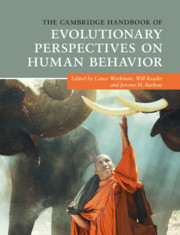Book contents
- The Cambridge Handbook of Evolutionary Perspectives on Human Behavior
- The Cambridge Handbook of Evolutionary Perspectives on Human Behavior
- Copyright page
- Dedication
- Contents
- Figures
- Tables
- Contributors
- Preface
- Acknowledgments
- Part I The Comparative Approach
- Part II Sociocultural Anthropology and Evolution
- Part III Evolution and Neuroscience
- Part IV Group Living
- Part V Evolution and Cognition
- Part VI Evolution and Development
- Part VII Sexual Selection and Human Sex Differences
- 26 Survival, Selection, and Sex Differences in Fear
- 27 The Enigmatic Urge
- 28 Are Humans Peacocks or Robins?
- 29 Human Mate Selection
- 30 Kin Selection and the Evolution of Male Androphilia
- 31 Evolutionary Psychology
- Part VIII Abnormal Behavior and Evolutionary Psychopathology
- Part IX Applying Evolutionary Principles
- Part X Evolution and the Media
- Index
- References
30 - Kin Selection and the Evolution of Male Androphilia
from Part VII - Sexual Selection and Human Sex Differences
Published online by Cambridge University Press: 02 March 2020
- The Cambridge Handbook of Evolutionary Perspectives on Human Behavior
- The Cambridge Handbook of Evolutionary Perspectives on Human Behavior
- Copyright page
- Dedication
- Contents
- Figures
- Tables
- Contributors
- Preface
- Acknowledgments
- Part I The Comparative Approach
- Part II Sociocultural Anthropology and Evolution
- Part III Evolution and Neuroscience
- Part IV Group Living
- Part V Evolution and Cognition
- Part VI Evolution and Development
- Part VII Sexual Selection and Human Sex Differences
- 26 Survival, Selection, and Sex Differences in Fear
- 27 The Enigmatic Urge
- 28 Are Humans Peacocks or Robins?
- 29 Human Mate Selection
- 30 Kin Selection and the Evolution of Male Androphilia
- 31 Evolutionary Psychology
- Part VIII Abnormal Behavior and Evolutionary Psychopathology
- Part IX Applying Evolutionary Principles
- Part X Evolution and the Media
- Index
- References
Summary
Androphilia refers to sexual attraction and arousal to adult males, whereas gynephilia refers to sexual attraction and arousal to adult females. Male androphilia is considered one of the outstanding paradoxes of evolutionary biology because its very existence flouts our expectations concerning what constitutes an evolutionarily viable trait (Bailey & Zuk, 2009). In humans, male androphilia is heritable, as evinced by twin studies (Alanko et al., 2010; Bailey et al., 2000; Kendler et al., 2000; Långström et al., 2010), as well as research in the area of molecular genetics (Hamer et al., 1993; Mustanski et al.,2005; Sanders et al., 2015). Despite the heritability of this trait, androphilic males reproduce at far lower rates when compared to gynephilic males, if they reproduce at all, which, very often, they do not (e.g., Bell & Weinberg, 1978; King et al., 2005; Saghir & Robins, 1973; Schwartz et al., 2010).
- Type
- Chapter
- Information
- Publisher: Cambridge University PressPrint publication year: 2020
References
- 6
- Cited by



